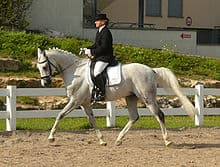Type the name of the breed you're looking for below
[wpdreams_ajaxsearchlite] Don't see the breed your're looking for? Click here and let us know!
Shagya Arabian Horse
| Country Of Origin | Hungary |
| History and Background | The Shagya Arabian was developed in the Austro-Hungarian Empire during the 19th century at the Bábolna, Mezőhegyes, Radautz, Piber, and Topolcianky studs. Today it is most often seen in the Czech Republic, Austria, Romania, the former Yugoslavian countries, Poland, Germany, and Hungary, but has been exported to other nations and is bred around the world. A purebred Shagya Arabian today has bloodlines that can be traced in all lines to the stud books of Rădăuți, Babolna, and Topolcianky. The breed is considered by some to be a subtype of Arabian horse, but due to the presence of a small amount of non-Arabian breeding others consider it to be an Anglo-Arabian or a partbred Arabian. One of the major founding sires was Shagya, a gray Arabian (or, some say part-Arabian) stallion with some ancestors of the Kehilan and Siglavy strains. Born in Syria in 1810, he was taller than the average Arabian of the time, standing 15.2 1⁄2 hands (62.5 inches, 159 cm) at the withers. He was mostly used for crossbreeding at Babolna, bred few pure-blooded or asil Arabian mares, and thus has no pure Arabian descendants today. Many of the Arabian stallions standing at Babolna and other studs were crossbred with mares who already possessed a great deal of Arabian influence due to the long Turkish occupation of Eastern Europe. Some Thoroughbreds and Lipizzans were also used. In all cases, meticulous pedigree records were kept. Originally, these predominantly, but not asil Arabian horses were referred to by the generic term Araberrasse (Arab "race" or breed, indicating predominantly Arabian ancestry) but this was changed after the second World War to Shagya by hippologist Dr. Gramazky because he was worried the non-purebred descendants of Shagya would be mixed up with the purebred Arabian horses that were also produced in Hungary. At the time, this name was chosen since Shagya was in virtually every pedigree as an ancestor, though many other Arabian bloodlines are also a part of the Shagya breed. Bloodlines; While Shagyas are not considered "pure" or asil Arabians, they have a closed stud book and have special status within the World Arabian Horse Organization (WAHO). In 1978, WAHO stated that Shagya Arabians that have been bred pure after the system of Babolna and Topolcianky may be termed "purebred Shagya Arabians", and the Shagya breeders' organisation is under WAHO patronage as associate members, allowed to use the WAHO emblem. However, WAHO also was clear that "purebred" in this case means that the horses have been bred pure among themselves and are not to be confused with the term "purebred Arabian". Some aficionados note that the meticulous recordkeeping of the Hungarian studs actually has produced horses with longer and more complete pedigrees than some horses accepted as purebred Arabians by mainstream registries. However, despite this argument, Shagyas remain a distinct bloodline group and are generally not accepted as pure-blooded Arabians. |
| Use Today | his breed is recognized as a riding horse, and is also driven in harness. It was a hardy cavalry horse and is now popular in sport horse disciplines such as dressage, eventing and endurance riding. The 2006 FEI Endurance World Champion was a Shagya gelding bred at Babolna. |
| Height | 15 – 16 hands (60 - 64 inches) |
| Colour | Chestnut, Bay, Black, Grey |
| Characteristics | Head is characteristically Arabian with dished profile Ears are small and set high Eyes are large and expressive Neck is long, slender and arched Back is slightly sunken Legs are strong with dry joints |
| Personality and Temperament | Docile, easy mannered, spirited and happy |



